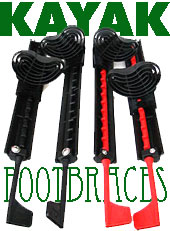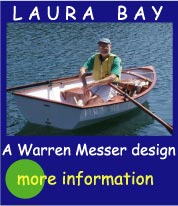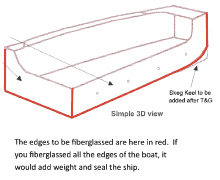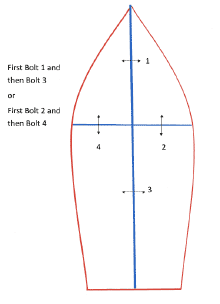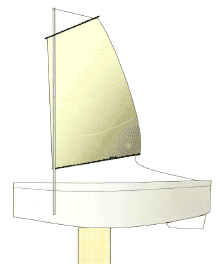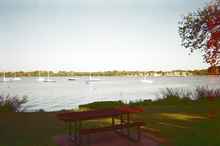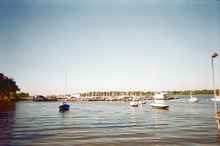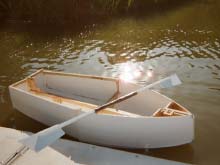
 Custom Search
|
| sails |
| plans |
| epoxy |
| rope/line |
| hardware |
| canoe/kayak |
| sailmaking |
| materials |
| models |
| media |
| tools |
| gear |
| join |
| home |
| indexes |
| classifieds |
| calendar |
| archives |
| about |
| links |
| Join Duckworks Get free newsletter CLICK HERE |
|
|
| Out There |
by Paul Austin - Dallas, Texas - USA April Love - Part Three |
 |
| Part One - Part Two - Part Three First let me say, it doesn't take a three part article to build April Love. I've just had real life interfere with getting to the lake. Now April Love is built and the sails are made, I'd like to look back at the building process to say a few things you'll need when you build your own version of this fine little ship.
First, 3/8 plywood would be much better than 1/8 plywood. The edges will be stronger, they'll cut cleaner and hold paint and glue. The better the plywood you buy, the less trouble any plywood boat will be. Then I think you have to fiberglass the edges which meet when the four pieces are bolted together. Remember, every time you use April Love, you'll be squeezing edges together. The first two times I took her to the lake, I had tiny leaks because the bolting process squeezed off paint. Fibreglassing the edge solved this immediately.
Second, I'd have a sequence of bolting. I'd suggest bolting the boat together in the same sequence every time. What I do is bolt the forward two sections together to 90% of their tightness, then bolt the two aft sections together to 90% of their intended tightness and then bolt the forward and aft units flush. Then I make all four bolts flush. I always bolt the aft units last; so I've drilled that bolt hole a little larger than the others. This way, there isn't so much pressure on that bolt when I get there that it chips away at the plywood around the hole. The bolting process takes me about 6-7 minutes, putting two sails on took 10 minutes longer. I've launched her in different places at White Rock Lake, off a pier and in 6 inches of water at the shore. If I could do the boat over, I'd put a skeg on the bow as well as the stern for protection. I used eyebolts for rudder hardware with a long screwdriver to hold the rudder. Not pretty but it sure is handy and quick.
If you rig a sail, this little boat does not need much sail. All you really need is about 40 square feet of sail. I've made a lug sail, just because I hadn't done that before. The line does not hold the spar flush to the mast. I don't know if this is a drawback, but April Love sails 45 degrees off the wind, so maybe the wind can curl around the mast to fill the luff. Or maybe not, I can't tell without putting tell tales in the sail. Finally, I have a method of carrying the boat. Remember, this is only 1/8 plywood, if you just grab the boat anywhere to carry it 20 yards to a ramp or dock or whatever, the plywood might give. So I just get an aluminum luggage two wheeler, put the stern on the wheeler upside down, pick up the bow and walk away. Nothing to it. Ken Simpson, the designer, says you can glue the two forward sections together and the two aft sections together, producing a two part boat instead of a four part boat. You can also do it the other way, gluing the two side pieces together. You can also just make it one boat. If you make it one boat from the beginning, keep in mind you will use more plywood. Ken is a master at laying out the pieces on the plywood a certain way for the four part boat which you could not do for a one part boat. So keep that in mind.
By the way, now that I have paddled April Love around White Rock Lake twice I've noticed something. Because of the pointed bow, when I paddle April Love she has a tiny fore and aft rock to her motion. It actually helps control oncoming waves and eliminates whatever flat-bottomed slapping might have occurred at such a low speed. Traditionally, rowboats can have a flatter bottom than a sailboat, so April Love actually sails better than you might think.
I sailed her once with a cat schooner rig. Unfortunately the pictures had so much glare off the tarp sails and water, they didn't turn out. But April Love performed better than I thought. Even with the schooner rig, she moves to windward. This may be due to the lee board and rudder being 3 feet deep under the water, with a square shape at the bottom. However I think there might be other reasons. First, with the side-to-side cut as far forward as it is, I think April Love has less of a lead than other 8 footers. I didn't have this in mind when I made the sails and shaped the boards, but it happened anyway. Second, the aft sections are fairly straight from the joint to the stern so when I lean the chine into the water it's a long sharp edge to hold course. I didn't cut any roach in the tarp sails. I did it that way because winds are so high in Dallas, I didn't want the sails to get too full. For me, April Love is a light air occasional sailboat and great rowboat. I took the cat schooner rig down to replace it with this single sail.
The single sail moves April Love easy in light air and on a reach. To windward, I can't tell a difference between two and one sail. With two sails, both sails have to be in nearly perfect trim to work together; with one I don't even think about the sail trim. What's best about April Love? Carrying each section up and down the stairs is easy. Bolting them together takes about 6-7 minutes. I can launch it about anywhere. It sails effortlessly. What might be a drawback? April Love is not a heavy weather boat. I have to wait for winds to calm under 10mph for April Love to be in her element. Paul https://crossingthoughts-paul.blogspot.com.au P.S I am now writing with Mike John on: |
|
